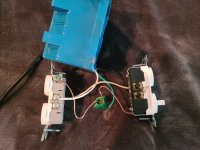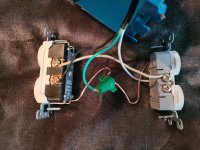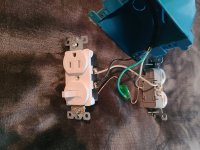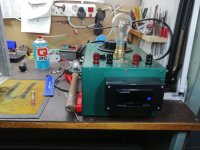I'm wondering if perhaps the prior test was not adequate. If folks think my wiring looks good I'll try plugging in a higher wattage lamp.
Oh yeah the pics help tremendously. I think you have it hooked up right, but I'll let the experts weigh in. I've only made two of DBTs and neither used the combo switch/outlet.
With the dbt powered up and the bulb in place, you should read 120vac at the duplex outlets when the switch is on, 0, of course when it's off. When that's proven to be the case, test with a larger load. Hair dryer, small heater or anything else that's a few hundred watts
Adding. After the initial valid 120vac reading at the duplex, repeat the same test with the lamp adapter unplugged from the switched outlet. Should read 0vac regardless of the switch position
Won't that blow a bulb if you're drawing hundreds of Watts through, say, a 100W bulb?Hair dryer, small heater or anything else that's a few hundred watts
I have measured the terminals, and moved on to using a bulb. When I switch it on, the bulb in the switched outlet lights, but not the 1 plugged into the duplex? That does not compute.
Last edited:
Are they different wattage? Is the first bulb limiting the current such that second (higher wattage?) bulb just doesn't have enough electrons to heat up the bulb filiment for the one in the duplex? If so maybe it's working and the little bulb is protecting the big bulb 💡 😉
I'm thinking about this and it doesn't make sense, I better go back and start with metering.
I think you're right that a heat gun will simply be limited by the bulb wattage. I don't know why I thought it would blow. Got my wires crossed I guess 😀2 channels, each biased at 1.3A light it up but not too brightly.
I just ran a 1550W heat gun from 0 to full-on using a 25W bulb and then a 100W bulb and the dbt did its current limiting job without blowing a bulb. Max current with 25W(40R) = ~.2A
100W(12R) = ~.5A
100W(12R) = ~.5A
I have confirmed with a meter, with nothing plugged in to the duplex I get 0 when switch is off & 110v when switch is on. Plug something in to the duplex and the bulb, switched side, lights but there is no longer voltage across the duplex outlets.
[Thought Experiment Only]
Let's say you plugged a paper clip in the duplex outlet to bridge the outlet and complete the circuit (Anyone reading this, please Do Not do this!), what voltage would you expect to get across the paperclip?
The "something" plugged in probably matters for the Vac measurement your taking.
Let's say you plugged a paper clip in the duplex outlet to bridge the outlet and complete the circuit (Anyone reading this, please Do Not do this!), what voltage would you expect to get across the paperclip?
The "something" plugged in probably matters for the Vac measurement your taking.
Last edited:
My only use for the dbt to date has been testing power supplies on initial power up. I've taken a few readings with various loads and the device appears to be very well suited to testing a linear supply on start up and little else.I have confirmed with a meter, with nothing plugged in to the duplex I get 0 when switch is off & 110v when switch is on. Plug something in to the duplex and the bulb, switched side, lights but there is no longer voltage across the duplex outlets.
The 40R of a 25W bulb will barely allow enough current turn a 15w fan. We'll below the speed of the ~ 7.5 watt low setting. Two such fans will light the bulb but do not operate.
The same two fans will run well below the normal rpm and dimly light a 100W bulb.
A 20V 200va transformer, FWB and a single 15000uF cap will briefly light the 25W bulb as the cap charges. Using a 100W bulb, the cap charges without lighting the bulb whatsoever.
Just for further reference.
A 400va 24vdc supply with 64,400uF per rail lights the 25W bulb for 3-4 seconds on power up and a second or less with a 100W bulb. No ICL and caps discharged between test
A 400va 24vdc supply with 64,400uF per rail lights the 25W bulb for 3-4 seconds on power up and a second or less with a 100W bulb. No ICL and caps discharged between test
My suggestions:
1. Plug in a "kill a watt" into the duplex receptacle, and plug the device under test to the "kill a watt" to monitor its Voltage, Ampere and Wattage.

2. Plug a power strip with individual switches and some incandescent bulbs (25W, 40W, 60W and 100W) into the "bulb" receptacle to select any wattage combination for testing.

1. Plug in a "kill a watt" into the duplex receptacle, and plug the device under test to the "kill a watt" to monitor its Voltage, Ampere and Wattage.
2. Plug a power strip with individual switches and some incandescent bulbs (25W, 40W, 60W and 100W) into the "bulb" receptacle to select any wattage combination for testing.
This is my 1kva jobbie, using a cheap Ali-express meter for power factor, amps, volts and some other things, has helped me to prevent " blitzen und sparken ", works great to work out transformer primaries without surprises. I use two outputs, one through the bulb and the other direct, works for me.
Attachments
- Home
- Amplifiers
- Pass Labs
- Aleph J Dim Bulb Tester Post




